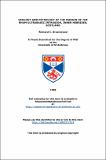Files in this item
Geology and petrology of the margin of the Rhum ultrabasic intrusion, Inner Hebrides, Scotland
Item metadata
| dc.contributor.advisor | Donaldson, Colin | |
| dc.contributor.author | Greenwood, Richard C. | |
| dc.coverage.spatial | 306 p. | en_US |
| dc.date.accessioned | 2015-08-04T14:45:13Z | |
| dc.date.available | 2015-08-04T14:45:13Z | |
| dc.date.issued | 1988 | |
| dc.identifier | uk.bl.ethos.234366 | |
| dc.identifier.uri | https://hdl.handle.net/10023/7123 | |
| dc.description.abstract | Country rocks surrounding the Rhum Tertiary ultrabasic complex have experienced severe thermal metamorphism, partial melting and mobilization resulting in the formation of extensive areas of intrusion breccia. Evidence from several sources indicates a maximum temperature in the country rocks of 960 ±40⁰C. Contrary to previous suggestions the complex was not emplaced as a fault block enclosed by a "Marginal Gabbro", but formed in situ at a depth of less than lKm. Large-scale layering continues to within 2m of the country rocks, and shows no change in either thickness or orientation close to the contact. Small-scale layers at Harris Bay thin and terminate towards the contact with the Western Granophyre. Strontium isotope data shows that the margins of the complex have experienced considerable crustal contamination. Contamination may have taken place by mixing of anatectic country rock melt with the resident basaltic liquid during boundary flow. Whole-rock and isotope geochemistry suggests that marginal microgranodiorite ("hybrid rocks") formed during a process of combined assimilation and fractional crystallization. Lead isotope data indicate that rocks of the ultrabasic complex, as well as earlier Tertiary granophres and felsites, were contaminated with Lewisian lead. The crustal level at which this took place and the processes involved remain unclear. Oxygen isotope analyses show that rocks of the contact zone have undergone large-scale exchange with heated, meteoric fluids. In response to inflation of the complex the country rocks experienced considerable deformation, and in places the chamber roof underwent gravity collapse. Deformation resulted in increased country rock permeability, thus enhancing hydrothermal circulation and promoting high-cooling rates along the ·contact zone. A consequence of this process is the local preservation of quenched ultrabasic material at Harris Bay, and the ubiquitous development of rapid growth textures in all lithologies within the contact zone. | en_US |
| dc.language.iso | en | en_US |
| dc.publisher | University of St Andrews | |
| dc.subject | Geology of Rhum Tertiary | en_US |
| dc.subject.lcc | QE264.R8G8 | |
| dc.title | Geology and petrology of the margin of the Rhum ultrabasic intrusion, Inner Hebrides, Scotland | en_US |
| dc.type | Thesis | en_US |
| dc.type.qualificationlevel | Doctoral | en_US |
| dc.type.qualificationname | PhD Doctor of Philosophy | en_US |
| dc.publisher.institution | The University of St Andrews | en_US |
This item appears in the following Collection(s)
Items in the St Andrews Research Repository are protected by copyright, with all rights reserved, unless otherwise indicated.

